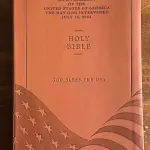 In a recent book, G. K. Beale speaks of The Erosion of Inerrancy in Evangelicalism
In a recent book, G. K. Beale speaks of The Erosion of Inerrancy in EvangelicalismI took a look at Beale’s book because it touches on two not unrelated subjects that interest me: the Christian doctrine of Scripture, and the relationship of the Bible’s cosmology to that of other ancient peoples and to modern science. Beale’s book will disappoint anyone who is not playing the defensive game of American conservative Evangelicalism. Such readers may take his claims on p.20 at face value, that the troubles for the conservative doctrine of Scripture arise from “eroding” influences from outside: postmodernism, and study at non-Evangelical schools. But surely, unless one wishes to posit a conspiracy to mislead and the gullibility of the students, then the study of the Bible at whatever institution ought not to have the results Beale suggests. Nor does he seem to entertain for a moment what seems to me a more plausible explanation: the doctrine of inerrancy is crumbling because thinking Evangelicals are studying the Bible more seriously, are being more honest about what it contains, and are beginning to allow their doctrine about what the Bible is to be determined by the Bible’s contents rather than vice versa.
The book proceeds with a series of case studies, which seem to indicate that Beale believes that if he can just show that his own viewpoint is not decisively disproven by the evidence, then he emerges victorious from the battle. This shows just how out of touch Beale is with contemporary Christianity.
In the chapter on the question of whether the book of Isaiah could have had multiple authors, Beale purports to be defending the Bible, but he is of course defending his doctrine of Scripture, and at times it becomes clear that he is determined to defend his doctrine of Scripture even from Scripture itself. Rather than allow the contents of this influential and powerful prophetic book to determine his conclusion, he is determined to force it into a straightjacket determined by his presuppositions about the Bible in general, and about the meaning of the New Testament when it refers to “Isaiah” in particular.
 Beale regularly waves reference to “phenomenological language” as though it were a magic wand that can make outmoded cosmological language cease to be a problem. While he may be correct about the Temple connections in Israel’s thinking about creation, this does not change the fact that ancient Israel’s authors used language so similar to that of Israel’s neighbors that, if not meant literally, it opened the way for a great deal of potential confusion and misunderstanding in that context. But ultimately, the reason Beale draws the conclusions that he does is a lack of familiarity with ancient cosmologies. His discussion of whether the planets could have been embedded each in a separate dome, to account for their distinct movements, ends with the statement that “Such a view of multiple domes, however, cannot be found to have existed in the ancient world!” (p.199). Perhaps not domes, but certainly complete spheres, made of “quintessence”, in which the planets and the sun and moon were embedded. Far from being unprecedented in the ancient world, this is the very ancient viewpoint, the Ptolemaic cosmology, that came to dominate much of Europe and Asia, and persisted until the time of Galileo. Since it takes very little research to become aware of this, I can only assume that Beale’s interest is not in doing justice to questions of ancient and modern cosmologies and the Biblical context, but of defending his view of Scripture at all costs.
Beale regularly waves reference to “phenomenological language” as though it were a magic wand that can make outmoded cosmological language cease to be a problem. While he may be correct about the Temple connections in Israel’s thinking about creation, this does not change the fact that ancient Israel’s authors used language so similar to that of Israel’s neighbors that, if not meant literally, it opened the way for a great deal of potential confusion and misunderstanding in that context. But ultimately, the reason Beale draws the conclusions that he does is a lack of familiarity with ancient cosmologies. His discussion of whether the planets could have been embedded each in a separate dome, to account for their distinct movements, ends with the statement that “Such a view of multiple domes, however, cannot be found to have existed in the ancient world!” (p.199). Perhaps not domes, but certainly complete spheres, made of “quintessence”, in which the planets and the sun and moon were embedded. Far from being unprecedented in the ancient world, this is the very ancient viewpoint, the Ptolemaic cosmology, that came to dominate much of Europe and Asia, and persisted until the time of Galileo. Since it takes very little research to become aware of this, I can only assume that Beale’s interest is not in doing justice to questions of ancient and modern cosmologies and the Biblical context, but of defending his view of Scripture at all costs.
 And yet, ironically, Beale is ultimately no friend of inerrancy. For in allowing that the Bible speaks about things as they appear, and not necessarily as they are, Beale has opened all the cans of worms he surely hoped to keep sealed up. If matters of cosmology can be described phenomenologically, then so can matters pertaining to our salvation. And perhaps in most instances this will seem fine to all but the most conservative of Christians. Jesus’ death was like a sacrifice, our experience as Christians is like being brought from death to life, getting a new start is like a new birth. But what if the early Christians’ experience of Jesus was like encountering the same human person having been physically-resurrected? Inerrancy is a zombie concept that has remarkably persisted for decades in spite of long having died the death of a thousand qualifications. The only hope for Beale and other supporters of the doctrine is that no one will ask the sorts of awkward questions or point out the awkward evidence that we’ve only scratched the surface of here. But I am persuaded that those days are gone, perhaps not for an older generation of conservative Christians, but for that which is growing up today. And if the stalwarts of the old guard want to protect their flocks from inconvenient truths, it will take not just sending them to Evangelical schools, but somehow censoring their internet access as well, not to mention protecting them from looking at the Bible’s actual contents too closely. And once conservative Evangelicalism shows itself to be able to persist only under that sort of totalitarian regime, its downfall is assured. The Bible tells me so.
And yet, ironically, Beale is ultimately no friend of inerrancy. For in allowing that the Bible speaks about things as they appear, and not necessarily as they are, Beale has opened all the cans of worms he surely hoped to keep sealed up. If matters of cosmology can be described phenomenologically, then so can matters pertaining to our salvation. And perhaps in most instances this will seem fine to all but the most conservative of Christians. Jesus’ death was like a sacrifice, our experience as Christians is like being brought from death to life, getting a new start is like a new birth. But what if the early Christians’ experience of Jesus was like encountering the same human person having been physically-resurrected? Inerrancy is a zombie concept that has remarkably persisted for decades in spite of long having died the death of a thousand qualifications. The only hope for Beale and other supporters of the doctrine is that no one will ask the sorts of awkward questions or point out the awkward evidence that we’ve only scratched the surface of here. But I am persuaded that those days are gone, perhaps not for an older generation of conservative Christians, but for that which is growing up today. And if the stalwarts of the old guard want to protect their flocks from inconvenient truths, it will take not just sending them to Evangelical schools, but somehow censoring their internet access as well, not to mention protecting them from looking at the Bible’s actual contents too closely. And once conservative Evangelicalism shows itself to be able to persist only under that sort of totalitarian regime, its downfall is assured. The Bible tells me so.












